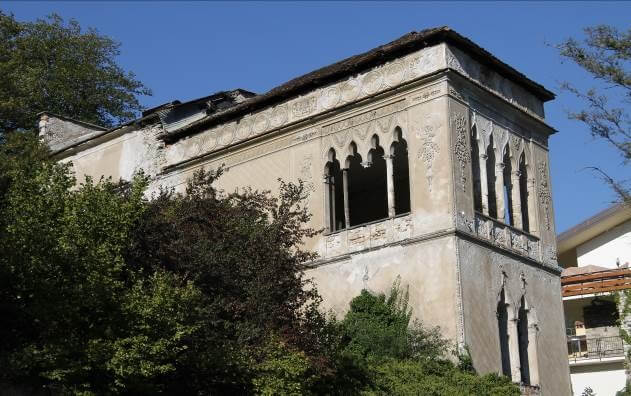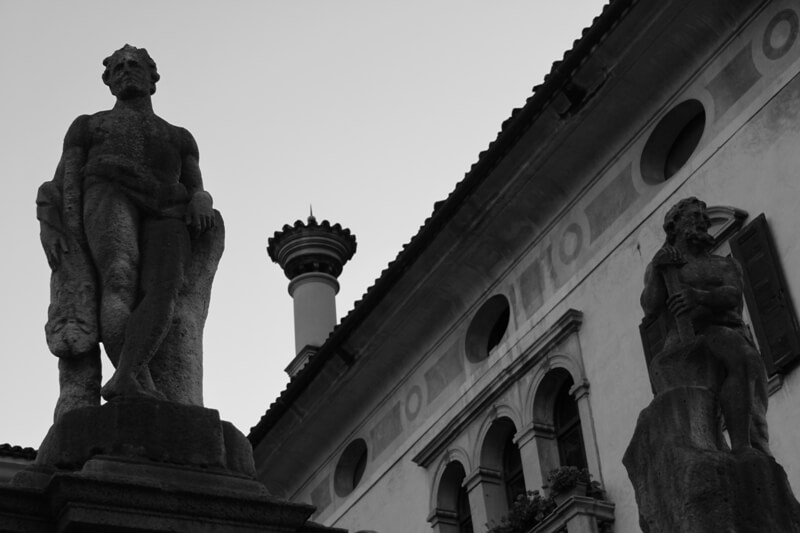Villa Crotta - de' Manzoni
 Dimore storiche
Dimore storiche
Descrizione
Villa Crotta-de'Manzoni la più settentrionale del¬le ville venete, è un complesso edilizio sorto tra il XV-XVI sec. nel cuore della cittadina ed è frutto di secoli di ampliamenti e modifiche. Al suo interno conserva un intero ciclo di affreschi di Pietro Pao¬letti (1801-1847). All'esterno invece, i giardini sono abbelliti da statue raffiguranti divinità paga¬ne e personaggi in costume. Nell'estremità meri¬dionale del parco sorge il rustico della Toresella che risale al XIX sec.; utilizzato come luogo di svago, dove ci si poteva intrattenere per il the e la musica, con l'inconfondibile paesaggio dolomitico. Accanto alla Villa si trova “El Broi”, un ampio spazio erboso di circa un ettaro, circondato da un doppio filare d'acacie e siepi, strettamente vincolato al gioco dei bambini o utilizzato per manifestazioni di vario genere.
Il lato che dà su Piazza Libertà è abbellito da un' antica fontana sormontata da un leone di San Marco, simbolo del dominio veneziano, mentre il lato occidentale si chiude con il Palazzo Munici¬pale già sede dell' Istituto Minerario “U.Follador” fondato nel 1867, tra le più rinomate scuole di specializzazione esistenti in Italia.
Villa Crotta-de'Manzoni
Villa Crotta-De'Manzoni, the northernmost of the Venetian Villas, dates back between the 15th and 16th centuries: it is in the heart of the town and is the result of centuries of extensions and alterations. Inside we can find a comprehensive series of frescoes by Pietro Paoletti (1801-1847). The gardens are graced with statues of pagan divinities and figures in costumes. At the southern extremity of the park stands the rustic Toresella, dating back to the 19th century, used as place of leisure: to enjoy music over a cup of tea with a unique view of Dolomites’ landscape. Next to the Villa is "El Broi", a spacious grassy area of about an hectare: surrounded by a double row of acacia trees and hedges, an area restricted to children's playground and to host cultural or sporting events.
The Villa's side overlooking Piazza Libertà is adorned with an ancient fountain topped by a St. Mark's lion: symbol of Venetian supremacy, while the west side is closed-off by the Municipality building, formerly location of the Mining Technical & Industrial Institute Mining "U.Follador" founded in 1867, amongst the most renowned Italian specialistic educational institutes
Villa Crotta de Manzoni
Die Villa Crotta-De’Manzoni ist die nördlichste aller Villen des Veneto’s. Der zwischen dem 15. und dem 16. Jahrhundert entstandene Gebäudekomplex befindet sich im Herzen des Städtchens und wurde jahrhundertelang vergrössert und umgebaut. In seinem Innern befinden sich ein ganzer Zyklus von Fresken des Malers und Graveurs Pietro Paoletti (1801-1847). Im Aussenbereich werden die schönen Gärten durch zahlreiche Statuen von heidnischen Göttern und Personen mit Trachten ergänzt. Am südlichsten Rand des Parks befindet sich das Rustico della Toresella, welches aus dem 19. Jahrhundert stammt: es wurde vor allem als Ort des Vergnügens und der Unterhaltung genutzt; zum Genuss von Musik und Tee mit atemberaubenden Sicht auf die dolomitische Landschaft. Neben der Villa befindet sich «El Broi», ein grossflächiger, ca. einen Hektar grossen Rasen, welcher von einer Doppelreihe Akazien und Hecken umrahmt wird. Dieser Ort lädt zum Spielen und Verweilen ein und dient ausserdem Veranstaltungen aller Art. Die Seite zur Piazza Libertà ist durch einen antiken Brunnen verschönert, welcher von einem Löwen von San Marco überragt wird, Symbol der venezianischen Herrschaft. Die westliche Seite endet im Palazzo Municipale, Sitz des Mineralogischen Instituts «U. Follador», gegründet im 1867, eine der renommiertesten Spezialisierungschulen Italiens.
Villa Crotta-De'Manzoni, la más septentrional de las villas venecianas, es un complejo de edificiosconstruido entre los siglos XV y XVI. en la ciudad y es el resultado de siglos de expansiones y cambios. En su interior conserva todo un ciclo de frescos de Pietro Pao ¬ letti (1801-1847). Afuera, por otro lado, los jardines están adornados con estatuas que representan dioses de pago y personajes disfrazados. En el extremo sur del parque se encuentra la rústica Toresella que data del siglo XIX; Se utiliza como un lugar de recreación, donde puede entretenerse para el té y la música, con el inconfundible paisaje de dolomia. Junto a la Villa se encuentra "El Broi", una gran área cubierta de hierba de aproximadamente una hectárea, rodeada por una doble hilera de acacias y setos, estrechamente vinculada al juego infantil o utilizada para diversos tipos de eventos.El lado que da a la Piazza Libertàestá embellecido por una antigua fuente coronada por un león de San Marco, símbolo de la dominación veneciana, mientras que el lado occidental cierra con el Palazzo Munici¬pale, que ya alberga el Instituto de Minería U.Follador fundada en 1867, entre las escuelas de especialización más reconocidas de Italia.


